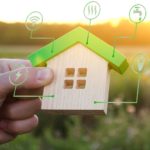Sector - Sustainability
2021: The Year of Greener, Smarter Construction

Kas Mohammed is the Vice President of Digital Energy at Schneider Electric UK & Ireland. With a decade of experience at Schneider, Kas is passionate about transforming and decarbonising buildings, whether new or old, with smart, sustainable solutions across energy generation, power, IoT and building services. In this latest piece, Kas shares his predictions for construction in 2021 – a greener, smarter and more collaborative industry.
Construction companies can’t ignore climate responsibility and the events of 2020 proved it. Despite the monumental personal, professional and political challenges throughout the year, sustainability remained a key talking point within the public, and a key differentiator for businesses.
With ‘Greener Buildings’ featured as one section of the UK government’s 10-point plan towards a Green Industrial Revolution, a spotlight will no-doubt be shone on the construction sector in 2021, and fines and reputational damage are likely to follow for companies unable to get on-board with this initiative. With the built environment contributing to around 40% of the UK’s total carbon footprint, building companies and professionals clearly have a major part to play in this movement.
This pressure has become increasingly noticeable for construction companies this year. Customers and legislators are constantly pushing them to design and deliver buildings that enable fast and effective carbon reduction at an efficient cost. This is only possible by building a new generation of smart buildings that place digital technologies and data at their foundation.
Building back smarter
Construction companies are now required to measure and limit the carbon impact of their projects from a full-lifecycle perspective. The UK Green Building Council (UKGBC) Framework, for example, aims to reduce carbon emissions at all stages of construction work. To comply with this and other standards that are sure to be put in place in 2021, construction companies will need to carry out a whole-life carbon assessment of their project to identify areas for improvement and opportunities for carbon reduction.
For the greatest impact, this should be carried out in multiple phases – the first occurring during concept design or at least before technical design work begins. This ensures decarbonisation is considered from the outset and efforts can be carried out in all subsequent stages of the project. A final assessment must then be made at the practical completion stage, giving the constructor the opportunity to measure their carbon impact and see what can be offset to achieve a net-zero construction.
However, a full lifecycle approach to decarbonisation also requires consideration of the building’s operational phase. Constructors have a vital but often overlooked role to play in the whole lifecycle of a building. Traditional buildings rarely have digitally connected systems in place that deliver the information they need to keep track of key information. Managers require insight to make a positive intervention, but that insight depends on real-time continuous data that must be delivered during construction.
Going into the new year, a construction company’s ability to deliver this will be dependent on their adoption of smart-building technology. If we are to truly ‘build back greener’, digital technology and decarbonisation will have to be placed at the centre of every construction phase, from inception to operation. By implementing the latest digitised tools and capabilities in 2021, construction companies will benefit from the facilitation of unprecedented insight and enhanced competitive differentiation.
Making the change
First and foremost, these smart buildings require a layer of Internet of Things-connected devices and sensors embedded at key points of the energy infrastructure. This could include smart circuit-breakers or energy sensors keeping track of energy usage in the building’s heating, ventilation and air-conditioning system.
A smart building then needs an open and interoperable operations backbone that connects these devices to the central building-management system. This IP and data backbone is crucial for providing continuous, real-time insight into energy usage. It allows them to monitor, measure and control all data from building and IT systems to ensure energy responsibility and efficiency.
With unprecedented visibility at their fingertips, organisations can identify key areas of wasted energy and eliminate them. Over a period of a few months, they will be able to see which systems are the worst carbon offenders in the mid-to-long term and intervene to cut any waste. This is far less painful and disruptive than undertaking arbitrary carbon-reduction programmes across the company.
However, these digitised buildings aren’t just attractive from an environmental perspective. In the aftermath of interrupted work and potential loss of revenue this year, 2021 will be a year of businesses streamlining costs and making back losses incurred during the pandemic. Energy efficiency can aid this. Energy and utility costs in buildings are a major cost centre for their owners. Construction companies will therefore have a dual case to make to customers in favour of smart buildings, as they not only save the planet, but also help them to significantly streamline costs.
Going forward, sustainability efforts must become more collaborative across the industry to ensure businesses thrive whilst making effective changes. Organisations such as the UKGBC, which Schneider Electric is a member of, offer support to construction companies of all sizes and stages in their move to greener building practices. In 2021, we can expect to see industry-wide cooperation have significant effects on the viability of construction firms in a greener world.
To remain competitive, keep fulfilling customer needs and meet new government and industry expectations, construction firms will depend on the advantages of smart building technology moving into the new year. Carbon reduction throughout the building cycle will be a key consideration for business resiliency and competitiveness. So, successful firms will use 2021 to start building their structures from the ground up with a digital-first mindset, ensuring their customers can achieve their carbon ambitions with ease.
If you would like to read more like this, then please click here
Related Articles
More Sustainability Features
- Landfill tax will not enable the circular economy
11 Dec 25
The National Federation of Builders (NFB) has released a short report titled, ‘Going full circle: Making a circular economy work for builders’,
- Why sustainability fails without structural engineers
9 Sep 25
Development firms could benefit from in-depth structural engineering knowledge
- Solar on all new homes must align with 1.5 million homes target
20 Jun 25
The Government have said that solar panels will be included in the FHS, leading to installation on the vast majority of new build homes.






